An average of 40 is the holy grail for test batsmen across the globe. 40 is the number which defines a batsman's legacy, determines his place amongst the pantheon of greats unless the said batsman happens to be a certain William Gilbert Grace.
To average above 40 at the end of one's test career is a fantastic achievement in itself, and is a hallmark of great consistency. Accentuating on the consistency bit, there are certain batsmen who have maintained an average in excess of 40 throughout the entirety of their test careers, their average never falling below the 40 mark, not for one single inning.
Taking a minimum qualification of 30 test innings, 20 batsmen make the cut. England lead the chart with 5 batsmen whereas Zimbabwe and New Zealand are unrepresented.
Virender Sehwag, Kevin Pietersen, Neil Harvey, Michael Slater, Jimmy Adams, George Headley, Adam Voges and Douglas Jardine are all unfortunate to miss out as their test average dipped below 40 for exactly one inning.
For future reference: Peter Handscomb, Kevin O' Brien, Tom Blundell and Aiden Markram's test average has never been below 40, but they are yet to cross the required threshold of 30 test innings.
It is an elite group to be a part of, one which features a War veteran and some all-time test greats. If the 4 gentlemen mentioned above manage to get there and stay put throughout the rest of their test careers, it would be one heck of an achievement.
For the moment, let us find out who the batsmen on this list are: (20-11).
(20) Herbert Collins (Australia): 1920-1926
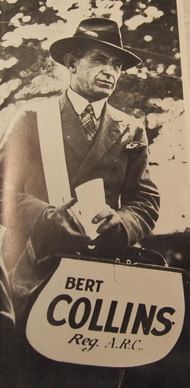
Matches: 19, Runs: 1352, Average: 45.07, Highest: 203, 100/50: 4/6.
Lowest Career Average: 45.07 (19th Test)
Herbert Collins' test career ended on a controversial note as allegations of match-fixing surfaced. Though unproven, the incident left a sour taste, more so, as Collins was the captain of the Australian cricket team.
It was a crying shame as Collins was colossal of Australian cricket, and played a major role in its re-building post the First World War.
A War soldier, Herbert Collins made his test debut at the age of 32 in Sydney, 1920. Collins immediately made an impact, scoring 70 and 104 in his debut test. He made 50+ scores in his first four test innings and ended the series as the leading run scorer with 557 runs to his name.
Australia white-washed England for the first time in a 5 test series (a feat not repeated again till the 2006/07 series).
A right-handed opening batsman, Herbert Collins played 19 tests in his career. He scored 1352 runs in those tests at an average of 45.07. It included 4 hundreds and 6 half-centuries, the highest being a masterful 203 against South Africa at the Wanderers in 1921.
Collins is also one of the few cricketers to have never been dismissed for a duck during the course of their entire test career. Collins also captained Australia in 11 tests, winning 5 and losing 2 of them.
Herbert Collins lost the prime of his test career due to the First World War, but he was an incredibly consistent batsman during his six-year tenure as an international cricketer.
Collins averaged above 50 for the major part of his test career, his numbers nosedived only at the very end. In fact, Collins lowest career average of 45.07 was registered after his final test innings.
(19) Geoffrey Pullar (England): 1959-1963
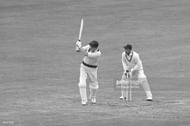
Matches: 28, Runs: 1974, Average: 43.87, Highest: 175, 100/50: 4/12.
Lowest Career Average: 41.62 (17th Test)
Geoffrey Pullar debuted into an England setup that had the likes of Ken Barrington, Peter May and Colin Cowdrey present in there. It meant that Pullar was pushed to open the batting, a position he had never batted at, prior to his test debut. Pullar was unfazed and responded in style.
He scored 75 against India in his first test and followed it up with a century in his next test. In the process, Pullar became the first Lancastrian to score a test hundred on his home ground.
Pullar also played a crucial role in England registering their first series victory in West Indies in 1960. Pullar scored 385 runs at an average of 43 as England won the 5 test series 1-0. More than the runs, it was Pullar's defiance that stood out.
While he did not score the daddy hundreds, Pullar bravely negotiated the new ball, paving the way for an unlikely series victory.
Multiple injuries and allergies meant that Geoffrey Pullar played only 28 tests in his career. He fell agonizingly short of the 2000 run milestone and finished his career with 1974 test runs. His highest score of 175 was a match-saving knock against South Africa at Edgbaston in 1960.
Pullar is one of the few batsmen to have opened the batting and batted at No.11 in the same test. The said incident took place against South Africa at The Oval in 1960. He scored 37 and 1* in that match. Pullar was selected as one of the Wisden Cricketers of the year in 1960.
Pullar's lowest career average of 41.62 came after he was dismissed for a pair against Pakistan at Lahore in 1961. The Southpaw scored 2 hundreds and 3 half-centuries in his next 5 tests, and was averaging above 50 at one stage.
A terrible Ashes series Down Under meant that Pullar's average plummeted down to 43.87, thus bringing an unceremonious end to his memorable test career.
Geoffrey Pullar did not achieve the dazzling heights many people thought that he was capable of, but he was a very reliable batsman who made the most of his limited opportunities. His presence on this list is further proof of the same.
(18) Lawrence Rowe (West Indies): 1972-1980
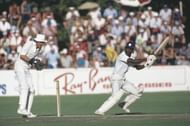
Matches: 30, Runs: 2047, Average: 43.55, Highest: 302, 100/50: 7/7.
Lowest Career Average: 43 (29th Test)
In the 141 year history of test cricket, no batsmen have had a better test debut than Lawrence Rowe. Rowe scored 214 and 100* in his debut test against New Zealand at Sabina Park, Jamaica in 1972.
Soon after, Rowe had a triple century to his name: a magnificent 302 against England at the Kensington Oval in 1974. Rowe averaged 71 after his first 13 tests and had already scored 6 hundreds by then. Sir Garfield Sobers believed that Rowe had the potential to be West Indies' greatest ever batsman, but it all fizzled out eventually.
Lawrence Rowe had the world at his feet, but ill-timed injuries and a poor work ethic meant that Rowe never lived up to his great potential. There were flashes of brilliance, Rowe's 107 against Lillee and Thomson at the Gabba is the stuff of legends, but such knocks were few and far between.
The final straw came after Rowe led the rebel tour to South Africa; it finished his international career with immediate effect and made him a pariah in his hometown of Jamaica: a place where he had scored 567 runs at an average of 113.
Lawrence Rowe managed only 30 tests in his 8-year career. He scored 2047 runs in them, the 2000 run milestone was achieved in the final test only. He scored 7 hundred in his career, but only 1 in his final 17 tests. A fantastic start to his test career meant that Rowe's average never dipped below 40, but it was a rather close shave.
Rowe's lowest career average of 43 came in his second test last, but he scored a hundred and a fifty in his next two innings to keep himself afloat. Lawrence Rowe finished with a test average of 43.55, it was good but just not good enough.
(17) Mominul Haque (Bangladesh): 2013-Present
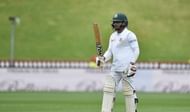
Matches: 29, Runs: 2170, Average: 43.40, Highest: 181, 100/50: 6/12.
Lowest Career Average: 41.60 (3rd Test)
In the era of the Big Four (Kohli, Kane, Root, and Smith), Mominul Haque has quickly established himself as one of the leading batsmen in world cricket. That Mominul had the potential to be Bangladesh's best ever batsman was never in doubt, but his ascend up to the top has been nothing short of staggering.
It is evident in the way the country views Mominul as well. When he was dropped for the home series against Australia in 2017, most of the questions directed towards the management were about Mominul's absence. He was reinstated in the side for the 2nd test of the series.
Mominul Haque made his test debut at the age of 21 in 2013. He scored a breezy 55 against Sri Lanka at Galle and has not looked back since. Mominul was the fastest Bangladeshi batsman to 2000 test runs and has scored 2170 runs in his career at an average of 43.40.
Despite being short in stature, Mominul is equally adept at playing pace as well as spin bowling. He recently became the first Bangladesh batsmen to score twin hundreds in a test match, when he scored 176 and 105 against Sri Lanka in January 2018.
After his first 3 test matches, Mominul averaged 41.60. One bad inning would have sunk his average, but the left-hander had other plans. Starting from his 4th test match, Mominul made a 50+ score in his next 11 tests, joining the likes of Virender Sehwag and Vivian Richards. His highest score of 181 also came during this period. Only Joe Root and Ab de Villiers (12) have done better than him in this regard.
Bangladesh has made significant progress in test cricket in recent times, and Mominul has been at the forefront of it. If Bangladesh is to continue on this path, Mominul has to take the mantle for them and make the transition from being a very good batsman to a great batsman. Mominul is the only Bangladesh batsman present on this list, and for Bangladesh to do well, he would have to stay here for the rest of his career.
(16) Conrad Hunte (West Indies): 1958-1967
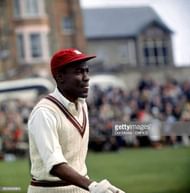
Matches: 44, Runs: 3245, Average: 45.07, Highest: 260, 100/50: 8/13.
Lowest Career Average: 41 (29th Test)
One of West Indies' greatest ever opening batsmen, Conrad Hunte made his test debut against Pakistan in his hometown of Barbados in 1958. Hunte had struggled to break through into the team, but once he did, there was no looking back.
Hunte scored a century in his debut innings and ended with scores of 142 and 11* in the match. The match is mostly remembered for Hanif Mohammed's magical 337. Hunte was overshadowed despite a great performance, it was a recurring theme in his career but Hunte was never deflated.
Hunte scored a fantastic 260 in his third test but was again overshadowed by Gary Sobers, who scored a monumental 365. Hunte finished the series with 622 runs at an average of 77, only George Headley and Sunil Gavaskar have scored more runs in their debut series.
There was a lull in Hunte's form after his debut series, but he bounced back in style in the famous 1960/61 series against Australia. Hunte scored 377 runs in the series but could not avoid a narrow defeat for West Indies. His role in the tied Brisbane test is a part of folklore.
Hunte was capable of aggressive stroke play but modeled his game for the need of the team. Hunte's lowest career average of 41 came after his 26th test, at the same time, he was overlooked for captaincy, but nothing seemed to impact him.
Hunte scored 473 runs in the next series against England in their backyard, which included 2 hundreds as well. He scored more than 1000 runs on the tour and was named as the Wisden Cricketer of the year in 1964.
Hunte retired after the tour to India in 1967, despite being in great form. It was on this tour that the flag incident took place, which established Hunte as a hero for thousands of Indian cricket fans. Hunte would work for several humanitarian causes in his life and remains as one of the greatest ambassadors this sport has ever seen.
(15) Faf du Plessis (South Africa): 2012-Present
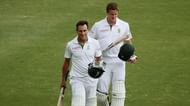
Matches: 54, Runs: 3302, Average: 42.33, Highest: 137, 100/50: 8/17.
Lowest Career Average: 40.60 (30th Test)
South Africa has produced some fantastic batsmen over the years, so it is a bit surprising that Du Plessis is the only batsman from the rainbow nation on this list.
While Du Plessis may not be one of South Africa's greatest batsman, he is one of the most important cricketers in South Africa's history. As a youngster, Faf considered going the Kolpak route but eventually decided against it. It proved to be a correct move in the long run.
Du Plessis made his test debut against Australia at Adelaide in 2012. He played one of the greatest debut innings of all time, scoring 110* as South Africa batted out 148 overs for a draw. South Africa would win the next test and the series, thus retaining their No.1 ranking.
Du Plessis scored 293 runs at an average of 146.50 in the series. He would build upon this and completed 1000 test runs in 15 tests. Du Plessis would earn himself the moniker of the Blockathon man for his ability to bat long periods in the 4th innings of a test match.
Faf's average had never been below 50 in his first 22 test matches. A horror tour to India in 2015 and a similar series against England at home meant that Du Plessis was dropped from the side in early 2016.
He made a sensational comeback as captain of the team in August 2016. His lowest average of 40.60 came after his first test as captain, but Du Plessis made a hundred in his next test, protecting his average and leading his side to a series victory over the formidable Kiwis. Their first series victory in over a year.
Du Plessis has taken over South Africa's reign with their Golden generation in decline, and the enforcement of transformation targets in the national team. He has juggled with all the responsibilities and led the team to series victories in Australia and New Zealand.
Du Plessis also became the first South African captain to win a series against Australia at home post-re-admission.
Du Plessis has played 54 tests in his career, scoring 3302 runs at an average of 42.33. He has scored 8 hundreds in his career, 4 of them as captain. Faf averages a respectable 43.78 as captain but has surprisingly never crossed 150 in his test career.
His highest score is 137, which he scored against New Zealand in his 4th test match. It looks highly improbable that Faf's average will down below 40, making him the most consistent batsman in South Africa's history.
(14) Frank Worrell (West Indies): 1948-1963
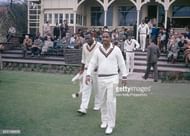
Matches: 51, Runs: 3860, Average: 49.49, Highest: 261, 100/50: 9/22.
Lowest Career Average: 49.49 (51st Test)
A batsman maintaining an average in excess of 40 is an amazing feat regardless, but it is all the more extraordinary in the case of Frank Worrell. Worrell's career lasted 16 years, but he played a mere 51 tests.
To maintain such consistency despite playing so few matches is quite astonishing. Frank Worrell made his test debut against England in the 2nd test of the 1948 series. The first test saw Everton Weekes and Clyde Walcott made their test debut, and in the next test, the three W's played together for the first time.
Worrell had a much better start to his career than his contemporaries. He narrowly missed out on a hundred in his first innings as he was dismissed for 97. Worrell did not have to wait for long, he scored 131" in the next test.
Worrell finished the series with 294 runs as West Indies won the series 2-0. Worrell, alongside Weekes, Walcott, Sobers, and Hunte formed the backbone of the team in the 1950s and made them the leading team of the decade.
Worrell continued on his merry ways with the bat. He completed 1000 runs in his 10th test, 2000 in the 22nd and 3000 in his 36th test, all the while maintaining an average in excess of 50. Worrell was appointed the captain of the West Indies team ahead of the 1960 tour to Australia.
West Indies lost the series, but Worrell united the dysfunctional team and won thousands of fans in Australia. Ultimately, the series between the two powerhouses was named after him
Worrell's last act on the cricket field was the 1963 tour to England. He struggled to score any runs but led his team admirably to a 3-1 victory. He announced his retirement soon after but continued to serve West Indian cricket to his utmost ability.
Worrell played 51 tests in his career and scored 3860 runs. Worrell scored 9 hundreds in his career, including 2 double hundreds and 3 other scores of 150+. Worrell played 87 innings in his test career and only thrice was his average below 50. His lowest career average of 49.49, which came after his final test innings was one such.
(13) Alvin Kallicharran (West Indies): 1972-1980
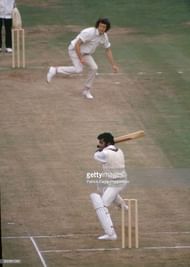
Matches: 66, Runs: 4399, Average: 44.43, Highest: 187, 100/50: 12/21.
Lowest Career Average: 44.31 (66th Test)
There are not a lot of players in world cricket that can lay claim to the elegance with which Alvin Kallicharran batted. A diminutive man, Alvin was destructive off both the front foot and the back foot.
Kallicharran made his test debut against New Zealand in 1972 and scored a fighting century. The left-hander made a hundred in his next test innings as well and finished the series with 2 hundreds to his name.
Kallicharran took a special liking to the Indian bowlers and is one of the few batsmen to have done well in India. He scored 992 runs in India at an average of 58. Kallicharran led the West Indies team in absence of Clive Lloyd, who had quit due to the Packer controversy. He led the team in 9 tests, winning 1 and losing 2 of them.
Captaincy did not seem to affect Alvin's batting as he scored 811 runs at an average of 54 while donning the captain's hat. His highest score of 187 also came when being the captain of the side.
Kallicharran was a very vital cog in the West Indies team that dominated world cricket in the 1970s. It is a shame then that he does not get enough credit for it. The Southpaw played 66 tests in his career, scoring 4399 runs at an average of 44.43.
Kallicharran scored 13 hundreds in his career, but failed to kick on to a double ton and crossed 150 only twice in his career.
Kallicharran's lowest career average of 44.31 came in his 66th test, which also turned out to be his last. He was going through a bad patch and was dropped from the team in controversial fashion.
He scored 12* in his final test innings against Pakistan at Multan in 1980. Kallicharran made the trip to South Africa in 1982 as a part of the rebel tour, thus ending any chance of a comeback to international cricket.
(12) Herbert Sutcliffe (England): 1924-1935
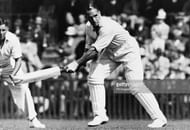
Matches: 54, Runs: 4555, Average: 60.73, Highest: 194, 100/50: 16/23.
Lowest Career Average: 60.73 (54th Test)
One of the greatest opening batsmen of all time, Herbert Sutcliffe made his test debut aged 30, in 1924. Sutcliffe scored 64 in his debut innings against South Africa in Edgbaston.
Sutcliffe scored a century in the next test and finished the series with 303 runs to his name. Sutcliffe made his first tour to Australia in 1924/25, and while England struggled, Sutcliffe thrived.
He scored 734 runs in the five test series, including 4 hundreds and 2 half-centuries. England lost the series 4-1, but Sutcliffe cemented his position as one of the leading batsmen in world cricket. He scored 472 runs in the 1926 Ashes as England won the Urn back. It was on this tour that Sutcliffe earned a reputation of being a bad wicket specialist.
When the going got tough, the Yorkshire man stepped up. He enhanced his reputation on the 1928 tour to Australia. Sutcliffe scored 303 runs at an average of 50, his knock of 135 at Melbourne is regarded as one of the greatest innings of all time.
Sutcliffe's test career came to an end after he failed to regain his fitness in the 1935 series against South Africa. Sutcliffe played for Yorkshire but never played for England again.
He formed one of the greatest partnerships with Jack Hobbs, the duo added 3249 runs at an incredulous average of 87. Sutcliffe found great success playing in Australia, he scored 1529 runs in 14 tests at an average of 63 including six hundreds.
Herbert Sutcliffe did not have a very attractive playing style, but he knew how to grind and make the ugly runs. Sutcliffe described himself as a batsman who loved a dog-fight, and his numbers sure tell that.
He played 54 tests in his career and scored 4555 runs at an average of 60.73. It included 16 hundreds and 23 half-centuries, but surprisingly, no double hundred. His highest score was 194 which he made against Australia at Sydney in 1932.
Sutcliffe is the only batsman, other than Bradman to have an average in excess of 50 in all four innings of a test match.
Sutcliffe retired with a test average of 60.73, which is mighty impressive by itself. That it was his lowest career average after he made his test debut at the age of 30 is a testimony to his great skill and perseverance.
(11) William Lawry (Australia): 1961-1971
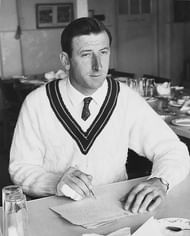
Matches: 67, Runs: 5234, Average: 47.15, Highest: 210, 100/50: 13/27.
Lowest Career Average: 40.29 (10th Test)
Bill Lawry will always be remembered for his commentary stint, but make no mistake about it, Lawry was one of Australia's finest cricketers. Lawry made his test debut in the 1961 Ashes in England.
Lawry scored 420 runs at an average of 52.50, including 2 hundreds and 2 half-centuries as Australia eked out a 2-1 series victory. Lawry continued on his merry ways, he brought up 1000 test runs in his 12th test with a fantastic 157 against South Africa at Sydney in 1961.
Bill Lawry captained Australia in 25 tests, winning 9 and losing 8. This may not look brilliant on paper, but it included two of Australia's greatest series victories. Lawry became the first Australian captain to win a test series in India in 1969.
The left-hander scored 239 runs as Australia won the five test series 3-1. In the Australian Summer preceding the Indian tour, Lawry's Australia registered an impressive series victory over Gary Sobers' West Indies.
Lawry was in fine form during that series, and lead the team from the front. Lawry scored a hundred in the first test at Brisbane, a test Australia lost. It was not to deter Bill, who scored a double hundred in the next test at Melbourne.
Lawry finished the series with a magnificent 151 on an underprepared Sydney wicket as Australia won the 5 test series 3-1. As it turned out, it was Lawry's test hundred as well. He scored 667 runs in that series. It was the second time Lawry had scored more than 500 runs in a series, he also scored 592 runs in the home Ashes of 1965.
Lawry was a free-flowing batsman when he started, but later re-invented his game and became a grafter, which ultimately led to his downfall. Lawry scored 321 runs at a strike-rate of 26 in the 1970/71 Ashes and was dumped midway in the series as a captain as well as a player as Australia lost the 6 test series 2-0.
A left-handed opening batsman, Bill Lawry played 66 tests in his career. He played 123 innings in his and opened in every single one of them. He scored 5234 runs in those tests at an average of 47.19. It included 13 hundreds and 27 half-centuries.
Lawry scored 2 double hundreds in his career, his highest score was 210 which he scored against West Indies at the Kensington Oval in 1965.
It is a testament to Lawry's brilliance as a commentator that whenever his name is mentioned, mind deflects to Lawry the commentator. But, Lawry was one of Australia's most consistent batsmen who lead to them some great victories.
Lawry barely misses out on the Top 10 of this list to a fellow Australian, but it does not take away any of his great accomplishments.
Looking for fast live cricket scores? Download CricRocket and get fast score updates, top-notch commentary in-depth match stats & much more! 🚀☄️
